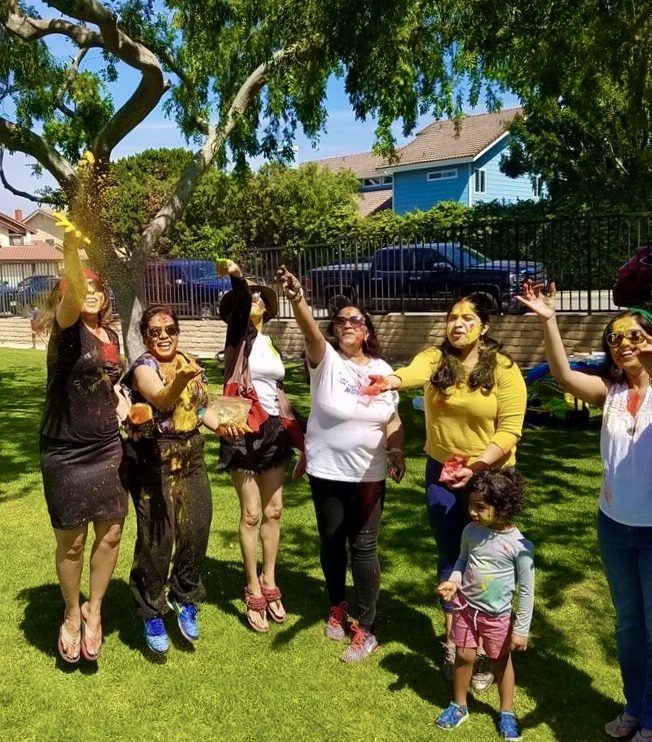Holi: India’s festival of love and colors
A festival of hue and harmony that brings color to a bland world
Indian families release colorful powders into the air during Holi or Holika
March 9, 2023
LOS ALAMITOS, CA — In the past, the Griffin Gazette has published various articles highlighting foreign cultures present in our local communities. This includes the tradition of Lunar New Year, which is celebrated all across East Asia and even here in America as a way to welcome spring. Likewise, there is another spring-welcoming holiday that takes place in this current month of March. Recently, it was the festival of Holi, or Holika, which is an Indian holiday coming from the country’s native religion of Hinduism.
This celebration is famous for its unique splashing of vibrant powders that catches the interest of many people. However, the sentimental importance of this holiday runs deeper than what we just see on the surface and represents principles that embody the vibrant characteristics of India itself.
The Hindu celebration of Holi originates from the Northern Regions of India, which include Uttar Pradesh and the capital area of Delhi. However, it has become popular throughout the entire country and even the entire world through Indian diaspora. Other countries that celebrate it include neighboring countries like Bangladesh and Nepal, but also the nations of the British Commonwealth like the UK, South Africa, Australia, New Zealand, and various spots in the Caribbean and Indian Ocean.
Those who have at least heard of the Hindu faith know that it possesses a pantheon of many gods and goddesses. In regards to Holi, it specifically celebrates the love held between the goddess Radha and the god Krishna. In Hindu folklore, Krishna was hesitant to confess his love to Radha due to their differences in skin color. Inspired by his mother’s advice, Krishna approached Radha and asked her to paint his face any color that is to her liking. This resulted in the two playing with different colors as they splashed a variety of paints on their faces. Ever since then, the Hindus used these vibrant color fights as a way to recreate how Radha and Krishna fell in love.
Beyond this, the holiday also commemorates the god Vishnu’s victory over the evil Hiranyakashipu. In this story, the evil Holika, which is where the day gets its name, died in a great fire. This victory is commemorated by the burning of large bonfires during festivity. The theme of good triumphing over evil is also seen in the other Indian holiday of Diwali, which takes place in November.
Like most cultural events, Holi features get-togethers with families as well as festive music and dance.
“Along with the picnic, we also play music and dance with each other!” said senior Sonrisa Dharr.
Most importantly, Holi is known for its color fights. Though the variety of colors may look like a chaotic mess, each color actually represents a specific value in the culture’s belief system.
“We take packs of colors and throw them at each other, [but] we make sure to wear clothes we don’t really care about,” Dharr said about the event.
Red dye, made from dried hibiscus flowers, is used to represent love. This is why Hindu women wear red tika markings on their forehead to display their marriage and is also the reason why red dye is spread on the faces of close family members.
Yellow Dye represents happiness during the festival and is typically made with the Indian spice of turmeric. For centuries, turmeric was incorporated into the nation’s food due to its health properties and as a part of ayurvedic medicine. This was the practice of using natural ingredients and food as medicine rather than lab-formulated chemicals like the ones here in the west.
As mentioned earlier, Krishna is one of the main gods who is worshiped during Holi. In celebration of him, blue dye is thrown during the festival as it is the same color as his skin. Since he is one of the religion’s many deities, his blue skin color is also used to convey immortality and bravery in the face of evil. Green dye symbolizes nature and new beginnings, which goes in line with the theme of Spring giving birth to a new season.
In addition, green also represents Islam, another major religion in India. Though Pink is used to show energy and purple royalty, perhaps the most symbolic color used in the festival is Saffron.
Even if it may just seem like orange, the distinct shade of saffron is one of the most important colors of Indian culture. Although the nation may be divided by different religions, they still united in sharing a common appreciation for this hue. Hinduism sees Saffron as representative for the sacral chakra, a person’s center of energy.
Another Indian religion from the region of Punjab, Sikhism, has important men such as gurus dye their sacred turbans in this color. The appreciation of Saffron across Indian cultures is the reason why it is displayed on the nation’s flag.
In the end, this contrasting mix of colors thrown in Holi serves as a greater representation of India as a whole. Though we may see people from that nation as Indian, the concept of one country called “India” is fairly new. Due to cultural, religious, and racial differences, people only referred to themselves with local identities for a long time. There was no “Indian,” but rather local identities like Punjabi, Rajasthani, Bengali, and more. It was not until 1946 that an independent Indian nation formed after they gained independence from the British Empire.
Even after gaining that independent identity, violent prejudice still took place, and still takes place, between the various religious and ethnic groups of India. However, the variety of colors in Holi symbolizes letting go of this divided past. Just like how the celebration emphasizes the birth of a new life with spring, the many colors and their symbolism represent a new life of harmony coming from these differing groups cooperating rather than fighting. With these contrasting colors representing different faiths like Hinduism, Islam, and Sikhism. The unification of these hues through Holi represents the union of these former rival groups in fun rather than violence.
Although this mixing colors may seem chaotic, it symbolizes the diverse spirit of India. Just like the colors, each ethnic and religious group in the country is different, but still united under one Indian identity.






